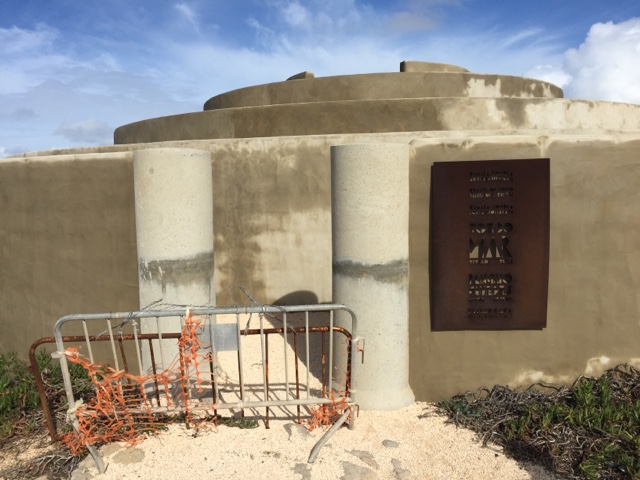Today I was taken to the European peninsula's most westerly point. The cape is called Cabo de São Vincente, Cape St Vincent, and is some 75km west of Ulf and Åsa's home, close to the town of Sagres, Algarve, Portugal.
Farol in Portuguese means lighthouse and that was our first stop for the day. Ulf was driving and Åsa and I came along for the ride.
The lighthouse and the area immediately around it was closed to the public but Cabo de São Vincente was still a very interesting and barren place.
Practice your Portuguese here.
The land on both sides around the lighthouse descended steeply into the water...
A familiar word and figure appeared on a sign at Cabo de São Vincente.
No, this is not part of Camino de Santiago de Compostela. GR11 instead is one of the European long distance walks, 840km long from here to Bay of Biscay.
As the sign notes, you can walk parts of it. I'm sure that it would be pretty spectacular walking up the coast.
The road leading into Cabo de São Vincente. There were quite a few tourists there and trailers were you could buy food and drinks but who can blame them. It was seriously rugged there.
From Cabo de São Vincente we moved onto Fortaleza de Sagres, at the next eastern point, Cape Sagres. Here we are looking back at Cabo de São Vincente.
A man known to history as Henrique I Navegador, Henry the Navigator, built a fort, fortaleza, here in the fifteenth century. He also set up a navigators school.
Only this chapel, although likely built later, and a large circle on the ground survive from Henry's days. A massive earthquake in 1755 destroyed it all as well as devestated Lisbon.
This was the point from which Henry oversaw the beginning of Europe's great adventure, the exploration and domination of the world.
Cabo de São Vincente was the end of the old world and Sagres was the beginning of a new one.
Today, you can pay a 3€ fee to get inside the compound and stroll around its edges, trying not to be blown away by the strong winds at this very exposed place.
This interesting building attracted our attention. Sure, you should not enter, but what is it really?
A close up of the sign makes it even more intriguing.
Inside, there were several openings through the ground and into presumably caves below. Where water had entered. Yes, from the chamber of sound you could hear waves crashing from somewhere below. I half expected a blowhole effect, of water coming up through the grid like a geyser right of a sudden. Of course that didn't happen but it was a strange experience.
After completing the stroll around the edges of the cape, it was time for lunch down at Sagres fishing harbour. At this interesting looking place that reminded me of now demolished Grotta Capri in Kensington, Sydney.
The restaurant walls up close looked like this. Bottles and rocks set into the walls in various patterns.
The white centre piece from the overview picture contained wine bottles, presumably with very good wine as there was also a display of awards won.
As we were waiting for our lunch to arrive, Ulf took the opportunity to do his homework for the Portuguese language course that they both attend. Today was another school day and the lecture would commence in less than 3 hours. Nothing like leaving things to the very end. Åsa, of course, had done her homework long ago.
The food arrived and I finally got to eat something from one of those famous Portuguese clay pots. My chosen dish was stuffed squid, Algarvian style, in a delicious garlicky sauce and with potatoes. Yummy food again. Regarding food and drink, I have eaten far better food in Portugal than in Spain, but the vino tinto at comparable prices is far superior in Spain than in Portugal.
After dinner, we drove to Portimão for Ulf and Åsa's Portuguese language class across this basketball court and behind the plane in the light yellow building.
The class would take 2 hours and a bit and spent that time wandering through the town of Portimão. Unfortunately the weather was not good, mostly rainy and windy.
My impression of Portimão was poor, probably at least partly because of the weather, but I found the town quite unattractive. Rio Arade was brown.
As I wandered along the streets of Portimão, I shot a few photos. Here the difference between the old building in the foreground clashed beautifully with the newer taller buildings behind.
After a stop at Ulf and Åsa's house after their Portuguese lesson finished, we went out to the adjacent town of Lagoa for dinner. At this place called Restaurante Lamim. Serving "tradicionalmente saboroso" according to their business card. It was another favorite of my hosts.
Of course, I scooped out whatever was left when both Ulf and Åsa were full. The feed was far too delicious to let go.
And as we got home, Ulf insisted that I tried another local delicacy. This spirit called Macieira.
The liquor could probably best be described as a mix of brandy and port wine. It did smell like brandy but the taste was a bit sweet. One glass was enough for me who am really just a beer and vino tinto person when it comes to alcohol.
Another gourmet eating day in Portugal. Tomorrow I will be on my own again and the food standard is bound to drop.






























No comments:
Post a Comment